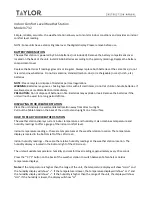
Appendix C: Accessing X-320TM Over the Internet
X-320M™ User's Manual
In the example, when a user on the computer needs to access a server on the Internet, the computer
sends the request to the router at 192.168.1.1. The router sends the request to the ISP server on the
Internet. The ISP server does not send the response directly to the computer on the LAN, but to the
router at the IP address of 266.70.164.97. The router then forwards the response to the computer. This
way, all devices on the LAN share a single public IP address. This is called Network Address Translation
(NAT).
Port Forwarding
The router can be configured to allow outside access to X-320M™ and WebRelay™. All requests from
the Internet to any device on the local network must use the public IP address (266.70.164.97). With
only a single IP address, TCP ports are used to identify the intended device for the incoming message.
Using the mailing address analogy, the port is similar to a post office box. The IP address specifies the
location, and the port specifies the specific recipient. Port numbers can be set to any number between 1
and 65235. However, many port numbers are reserved for specific applications and should be avoided.
As a general rule, numbers above 8000 are safe to use. All of the ControlByWeb™ products come from
the factory with the HTTP port set to 80, which is the standard port for HTTP. In this example, X-320M™
HTTP port will be changed to port 8000 and WebRelay™ port will be changed to 8001. Once the ports
are changed in the two ControlByWeb™ devices, the router must be set up for port forwarding.
Port forwarding associates the IP address of each local device with an assigned port. In this example,
the address 192.168.1.25 for X-320M™ would be associated with port 8000. The address 192.168.1.26
for WebRelay™ would be associated with port 8001. X-320M™ would be accessed from the Internet by
entering the public IP address of the router, plus the port number assigned to X-320M™ in the URL
window of the browser, http://266.70.164.97:8000. All Internet requests to the router for port 8000 would
be forwarded to X-320M™. Similarly, all request for port 8001 would be forwarded to WebRelay.
Note: When an HTTP request comes in to the router without the specific port specified
(http://266.70.164.97), the router will handle this as a port 80 request (default HTTP port). In other
words, http://266.70.164.97 is exactly the same as http://266.70.164.97:80.
Router configuration can vary widely. Some routers have the capability of translating the addresses and
the ports, which would require no port configuration change on the WebRelay. For example, the router
would be configured so that messages sent to http://266.70.164.97:8000 would be forwarded to
http://266.70.164.97:80, which is the default HTTP port.
Page 108
Xytronix Research & Design, Inc.
Figure Appendix C.2 - LAN Connected to the Internet
Summary of Contents for X-320m
Page 1: ......
















































